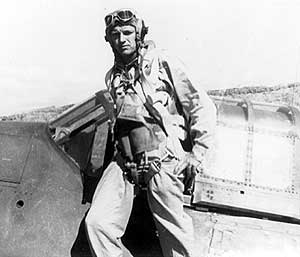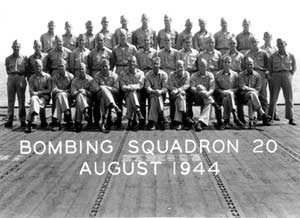
Then-ENS Robert J. Barnes of VB-20, on the wing of a Curtis Helldiver.
History:
Prewar -
1941 -
1942 -
1943 -
1944 -
1945 -
Postwar
The Ship -
All Hands -
Decorations -
Remembrance
In August l944, Bombing Squadron 20 (VB-20) embarked on USS Enterprise with Air Group 20 and the ship's first SB2C Helldiver dive bombers. The newer and faster Helldiver replaced the old, reliable SBD Dauntless. A later version of the Helldiver, the SB2C-3, was a much improved version of the original aircraft and proved to be a formidable combatant.
As one of the Helldiver pilots of VB-20, CDR Bob Barnes USN (Ret) gives his comments on the plane and some of his personal experiences while flying the Helldiver in combat from Enterprise. At the time he was an Ensign not long out of flight training. His rear seat aircrewman was Wallace J. Coulman ARM 1/c.
 Then-ENS Robert J. Barnes of VB-20, on the wing of a Curtis Helldiver. |
Apparently the early SB2C-1's, as the first built, had their problems and probably as a result I think there was a reluctance of some of the commanders to accept the Helldiver as a replacement for the reliable SBD Dauntless. The SB2C-3's that came out were much improved. From my experience it was a great dive bomber. It was faster than the SBD, easily carried 1000 lb bombs, and could carry drop fuel tanks for long range missions. On one mission they needed more planes to strafe an airfield, so they hung two pods of dual .50-cal machine guns under our wings. These were in addition to the two 20mm cannons and the 500 lb bomb already on our Helldivers. It was a very versatile aircraft.
Our Air Group 20, while deployed on Enterprise, covered much of the Pacific eliminating most Japanese air opposition, in preparation for the landings in the Philippines. This included strikes from Chichi Jima to Okinawa, Formosa, Yap, Palau, and the Philippines. Many attacks were made on enemy supply ships, various convoys and the Japanese fleet. Enemy anti-aircraft fire was always a problem. Here are a few memorable highlights with the Helldiver.
We headed for Formosa (Taiwan) to attack a very large Japanese airfield. We headed in with VB-20 leading the way under CDR Riera and VT-20 and VF-20 for fighter cover. As we got close to the target and ready to peel off for our dive, we heard the fighters on the radio say 7 Zekes (Japanese fighters) were heading to attack. I switched gas tanks to have a full tank and peeled off. On the way down - straight down - I was concentrating on the target, wind, etc., when I heard a tremendous explosion. The plane shook and at first I thought I had forgotten to switch tanks and the empty tank had caused the engine to backfire.
Here I was, in a dive through heavy anti-aircraft fire, with Jap fighters chasing me. I switched tanks again, released the bomb, pulled out and the engine quit. In the meantime, my rear seat aircrewman confirmed we had been hit in the tail by AA. I quickly checked my fuel tanks and then realized I had already switched tanks and in the heat of the moment had switched back to the low tank. After switching back to the full tank, the engine started. What a relief! I headed for our rendezvous for the return to Enterprise. After landing, it was found that the plane had a large hole in the vertical stabilizer from the AA that had hit and bursts which sprayed shrapnel holes all over the rear of the Helldiver.
The Japanese fleet was sent to counter General MacArthur's invasion of the Philippines. The enemy fleet was divided in three: two groups of battleships accompanied by cruisers and destroyers, approaching the Philippines from the southwest, and the third group of carriers escorted by light cruisers and destroyers, approaching from the north. This was to be a huge fleet battle!
On October 24, half of our Air Group was launched on a long range search for the enemy's Southern Force. The leader was the VB-20 Commanding Officer, CDR R. Emmett Riera. I flew in his division of six planes. Extra fuel tanks were hung under the wings of the Helldivers. We had twelve dive bombers, about the same number of torpedo planes from VT-20, and fighter cover from VF-20.
We found the Southern Force. What a sight! Two battleships accompanied by several cruisers and destroyers. Something you dream about as a dive bomber pilot. After this information was radioed back to our carrier we dropped our external fuel tanks and started our attack. The dive bombers started from about 12,000 feet and dove straight down, while the torpedo planes came in lower in a glide bomb attack and the fighters strafed. The anti-aircraft was terrific. Instead of the usual red, it was all colors. Apparently each ship had different colors to track their shells. We damaged both battleships with bomb hits. VF-20 Commander CDR Fred Bakutis was shot down and landed his plane in the water. One of our VB-20 planes dropped him a larger raft. He drifted for seven days before being picked up by a US submarine. The fleet battles were so intense there was no time to try to rescue him. This was a long range strike and we were in the air 5.7 hours total on that flight.
In the afternoon, a second wave of planes from VB-20 was launched against the middle Japanese Task Group, including of the super battleship Musashi. Many Air Groups pounded this naval force all day and Musashi was eventually sunk.
The next morning we were launched before daylight with twelve VB-20 Helldivers, and CDR Riera again leading the group of VB, VF and VT aircraft. I was again in Riera's division of the first 6 aircraft. Once airborne we learned of our destination, the Northern Japanese Task Group. We heard a search plane over this Japanese Force describe four carriers with cruiser and destroyer escorts: heard the words "Carriers are turning into the wind to launch aircraft." This was going to be even bigger than the day before. As it became light and we approached the Japanese, what a sight. It looked like the whole Japanese Navy, and this was our target. As Air Groups from other US carriers were arriving also, the target coordinator assigned VB-20, VT-20 and VF-20 one of the Japanese carriers, Zuikaku, to attack. Once again our Helldivers peeled off one at a time from 12,000 feet and dived straight down on Zuikaku. Numerous bomb hits were scored.
 Pilots and officers of Bombing Squadron aboard Enterprise CV-6, August 1944. |
The AA was the most intense I have ever seen, with all ships firing everything they had at our aircraft. After releasing our bomb we pulled out as low as we could near the water to avoid the AA. This meant flying out of through the middle of the enemy ships, while every ship you flew by was shooting at you. Believe me, the sky was solid red with AA. Continued attacks by other Air Groups during the day eventually finished the Japanese carriers. After our attack we rendezvoused outside the Japanese Task Force and headed for Enterprise. I got a direct bomb hit on a battleship the first day, 24 October, and a bomb hit on the Japanese carrier the next day. Our squadron had many rough days, but those two days were without a doubt the worst days of combat.
How could I not have affection and respect for the Helldiver that could get you through all that?
We lost many pilots and crewmen, and quite a few others were forced to ditch their aircraft due to damage or fuel starvation. On 12 October 1944, when we attacked Formosa, two of our Helldivers flown by LT Sam Tharp and LT(jg) George Muinch were hit by AA but were able to glide out to sea, to be picked up by our good old lifeguard submarines. One of my roommates, ENS Fred Turnbull from VF-20, was shot down that day and taken prisoner. I next saw him at a reunion 45 years later, in Pensacola. That same day, LT(jg) William F. Ross of VT-20 and his crew, Harry Aldro and Charles E. McVay, were shot down and captured. Sadly both crewmen were killed while prisoners. LT(jg) Ross was a prisoner throughout the war. That was one rough day!
At the reunion in 1989, Fred Turnbull told me the story of his capture. This is as I remember it. His aircraft was badly shot up. His squadron pilots told him on the radio, "Bail out, Shorty, bail out." He did, landing in the surf off the beach. Japanese soldiers dragged him on the beach with one shooting him in the shoulder. They decided to take him prisoner and took him to the hospital for treatment. A few days later a wounded Japanese fighter pilot was brought in the hospital after being shot down. Would you believe, he found out this was the enemy pilot that shot him down!
Looking back on those days, I can honestly say it was a real privilege to have served in VB-20 on USS Enterprise, and to have been a part of the history of that great fighting carrier.
Article and images courtesy Bob Barnes, and used here with his kind permission.
Image Library -
Action Reports and Logs -
News Stories
Message Boards -
Bookstore -
Enterprise CV-6 Association
Copyright © 1998-2003 Joel Shepherd ([email protected])
Sources and Credits